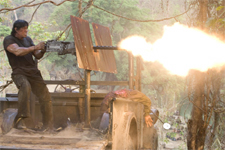Rambo
|
 John Rambo has always gotten a bad rap. Misunderstood by both characters in the movies he inhabits and the ideological watchdogs of the outside world who accused him of being a simplistic rightwing battering ram, Rambo has endured as many indignities as triumphs on the silver screen since he first walked down a country road in 1982's First Blood.
John Rambo has always gotten a bad rap. Misunderstood by both characters in the movies he inhabits and the ideological watchdogs of the outside world who accused him of being a simplistic rightwing battering ram, Rambo has endured as many indignities as triumphs on the silver screen since he first walked down a country road in 1982's First Blood.
As a cultural monument, he is best remembered as the cartoonishly buff instrument of American vengeance in Rambo: First Blood Part II (1985), the Reagan-era megahit in which the Vietnam veteran returned to Southeast Asia to finish the job the bureaucrats were too weak to let the American military win the first time around. The totality of that film's hawkish, bullet-strewn resurrection of U.S. military pride has since obscured the fact that Rambo was originally introduced in First Blood as a struggling loner who was summarily harassed and beaten by small-town Americana until he cracked and reacted with misguided, arguably psychotic vigor--American's own turning on itself. It has been exactly 20 years since Rambo's last appearance on screen in Rambo III, in which he traveled to Afghanistan to rescue his beloved colonel and help the Afghan rebels fight off the invading Soviet army. A lot has changed since then both geopolitically and cinematically, which is why the idea of bringing Rambo back to the big screen seemed like such a sad joke when rumors first started circulating. Because of the fundamentally misunderstood nature of Rambo's character, most people could only envision a simplistic, rabble-rousing ode to unquestioned military might. What could a cartoon like Rambo possibly have to offer in the post-9/11 era? As it turns out, a lot. As directed and cowritten by Sylvester Stallone, who also reprises the titular role, Rambo is a tightly wound, revisionary action fable about the sordid depths of human violence. What is truly daring about Rambo and what its most vocal critics have missed is the fact that Stallone has resurrected this iconic warrior not to celebrate his strength, but to lament his soul. When we first see John Rambo again, he is working on a river in Thailand and has all but given up on connecting with the outside world. He is, in every sense, a shell of a man, and Stallone's age (he's 61 now) gives the character a weighty, lumpy gravitas that was impossible to convey in the 1980s when he was all beefcake muscles and steely silence. Now his silence is labored and sad, and while Stallone's acting range has never been particularly impressive, he seems to have found a home in conveying weariness (he pulled off a similar feat two years ago in Rocky Balboa, which improbably resurrected the Philly pugilist for another round). It is interesting that Stallone's character is referred to in the film by his first name almost exclusively, which helps to remind us of his humanity: "John" is the person; "Rambo" is the myth (in this respect, it is unfortunate that they didn't stick with original title John Rambo, which neatly encapsulates this duality). The most immediately notable thing about Rambo is how graphically and relentlessly violent it is. While the resurrected Die Hard franchise took a turn into PG-13 territory last summer, Stallone goes the alternate route, delving headfirst into the kind of gut-churning viscera that is usually hinted at, but never shown in routine action movies. Some have waved the flag of exploitation, decrying Stallone's use of graphic violence as a cheap and lurid ploy while missing the inherent necessity of such imagery to Stallone's project. Like Sam Peckinpah did in The Wild Bunch back in 1969, Stallone is trying to shake us out of our complacency, showing us the visceral realities of what bullets, shrapnel, and fire does to the fragile human body. We've come to expect violence from action movies, but toned down enough that it maintains excitement without confronting us with its inherently ugliness. Rambo, on the other hand, is a decidedly ugly film; it's brutal in a way that few mainstream movies dare to be. Stallone and his effects team drive home this ugliness with a fevered intensity that will likely cause no end of consternation to many viewers, which is, of course, the point. Of course, there is always the argument that such a project is doomed to failure because some audiences will be exhilarated by the violence, however repulsive it is and whatever the director's intent may be. Even Peckinpah lamented how audiences got off on The Wild Bunch's apocalyptic bloodshed. Stallone and coscreenwriter Art Monterastelli (The Hunted) set the story in Burma, a country wedged between India and China that doesn't make the news very much even though some of the worst instances of human rights abuses and genocide have been taking place there regularly for decades. The film opens, in fact, with actual news footage of various atrocities that have taken place there in recent years, and that pixilated reality casts a dark pall over the rest of the film. The story is simple and direct: John Rambo is hired by a group of Christian missionaries to take them upriver into the war zone in Burma so that they can provide medicine and hope to the Karen villagers, who are being systematically killed off by the country's military government. The missionaries are captured after the village they are aiding is slaughtered by the army, and Rambo joins a group of hired mercenaries to rescue them. It's an ancient narrative, and it's deployed here with stark efficiency and no apologies. Yet, within this simplistic framework, Stallone manages to convey layers of complexity that might easily be missed. For example, the Burmese soldiers would seem to be the very epitome of one-dimensional evil: they machine-gun innocent villagers, enjoy drawn-out executions that first humiliate and terrorize the victims, and seem to take special pleasure in gang rape. Yet, early in the film it is made clear in both the actual news footage and in a staged scene in which the army raids a village that many of these soldiers are kidnapped boys who are forced into military service and beaten and dehumanized into soulless killing machines. Stallone doesn't force this issue, but it's there, and if it resides in the back of your mind throughout the film, it makes it much harder to delight in the battle scenes, for each Burmese soldier who is righteously killed represents the second death of a human soul. One might argue I'm reading too much into it, but I would counter that the film's critics aren't reading enough. It's a shame if the viewer's preconceptions overwhelm Stallone's accomplishments on the screen, which goes for both the critics expecting to see outdated militarist jingoism and the fans who are just looking to get a fix for their bloodlust. Rambo is a much more complicated film than either of these perspectives. The film is not perfect by any means, and Stallone largely botches the ending, which permits Rambo to fully and completely unleash his demons, yet doesn't do enough to convey what that means and how exactly it connects to the film's final images, which conclude on a quiet, pastoral note that neatly reflects the manner in which First Blood began all those years ago. In offering a lingering sense of hope that even John Rambo can go home in the end, the film unexpectedly caps a long-running series of violent escapades not with a bang, but with a whisper. Copyright ©2008 James Kendrick Thoughts? E-mail James Kendrick All images copyright ©2008 Lionsgate |
Overall Rating:



 (3.5)
(3.5)
Subscribe and Follow
Get a daily dose of Africa Leader news through our daily email, its complimentary and keeps you fully up to date with world and business news as well.
News RELEASES
Publish news of your business, community or sports group, personnel appointments, major event and more by submitting a news release to Africa Leader.
More Information
